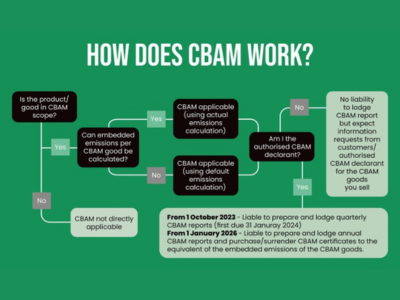In the global pursuit of a sustainable future, the Carbon Border Adjustment Mechanism (CBAM) emerges as a pivotal tool. Let’s delve into the intricacies of CBAM, understanding what it is and how it functions to reshape international trade with a green lens.
Understanding CBAM:
- The Essence:
CBAM, or Carbon Border Adjustment Mechanism, is a policy tool designed to tackle the carbon leakage challenge. Carbon leakage occurs when businesses, to evade stringent climate policies in one region, shift production to areas with lax regulations, ultimately undermining global emission reduction efforts. - Scope of Application:
CBAM is not a one-size-fits-all solution. It’s applicable to sectors that are energy-intensive and trade-exposed, meaning those industries highly reliant on energy and vulnerable to international competition. - Carbon Content Assessment:
The core principle involves assessing the carbon content of imported goods. The mechanism ensures that imported products are subject to the same carbon costs as domestically produced goods.
How CBAM Works:
- Emission Standards Benchmark:
CBAM sets an emission standards benchmark for a particular sector. This benchmark represents the average emissions that would be expected from the production of a specific good under the domestic climate policy. - Imported Goods Assessment:
When goods are imported, CBAM evaluates the carbon content associated with their production. If the emissions are below the benchmark, no additional charges are incurred. However, if the emissions exceed the benchmark, importers are required to pay the difference - Ensuring Fair Competition:
The objective is to ensure fair competition between domestic and foreign industries concerning carbon pricing. CBAM prevents carbon leakage by aligning the playing field, discouraging the relocation of industries to regions with less stringent climate policies. - Promoting Global Emission Reduction:
CBAM doesn’t only protect domestic industries; it fosters a global commitment to emission reduction. Countries exporting to regions with CBAM incentives are encouraged to implement similar policies domestically.
Challenges and Controversies:
- Complexity and Administrative Burden:
Implementing CBAM necessitates a robust system for measuring and verifying the carbon content of imported goods. This administrative burden could be a challenge for both exporting and importing nations. - Trade Tensions:
CBAM has the potential to spark trade tensions, especially if not implemented collaboratively. Striking a balance between environmental objectives and fair trade practices is a delicate task. - Impact on Developing Nations:
There’s a concern that CBAM might disproportionately impact developing nations, potentially hindering their economic growth. Striking a balance between climate goals and global equity becomes crucial.
The Path Forward:
CBAM stands as a bold initiative, navigating the complex intersection of trade, climate change, and economic policies. As the world grapples with the urgency of climate action, CBAM emerges as a beacon of hope, a mechanism not just to safeguard domestic industries but to foster a collective commitment towards a greener, more sustainable future.
In conclusion, CBAM is more than a regulatory measure; it’s a catalyst for transformative change in the global economic landscape. It represents a step towards harmonizing environmental sustainability with international trade, reinforcing the idea that economic prosperity can and should go hand in hand with ecological responsibility. As CBAM evolves and gets integrated into global trade frameworks, its true impact on shaping a greener, more equitable world will become increasingly evident.




